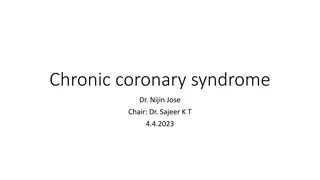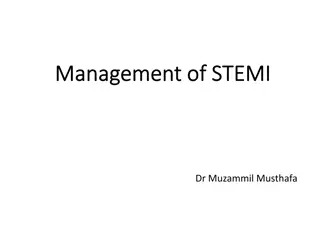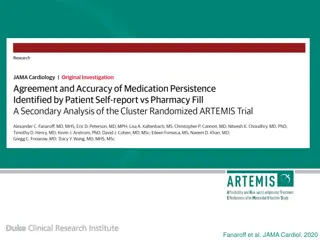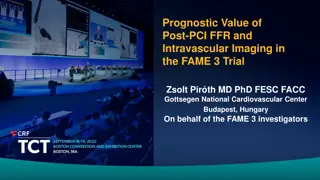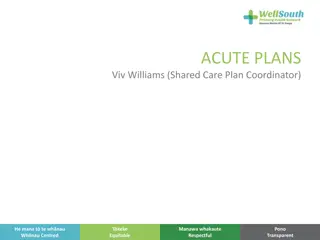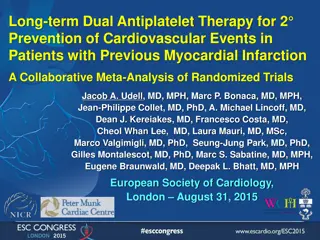Myocardial infarction
Myocardial infarction (heart attack), including its types, causes, symptoms, and first aid techniques. Discover how to recognize the signs of a heart attack and provide immediate care at home or in a hospital setting.
2 views • 14 slides
Understanding Alinity i STAT High Sensitivity Troponin-I for Cardiovascular Diagnosis
Alinity i STAT High Sensitivity Troponin-I is a proprietary assay used in diagnosing myocardial infarction (MI) by quantitatively measuring cardiac troponin I in human plasma. This chemiluminescent microparticle immunoassay (CMIA) aids in the detection of MI, a significant aspect in managing heart d
2 views • 30 slides
OCTIVUS Randomized Clinical Trial: OCT-Guided vs IVUS-Guided PCI
The OCTIVUS Randomized Clinical Trial compared the clinical efficacy and safety of Optical Coherence Tomography (OCT)-guided and Intravascular Ultrasound (IVUS)-guided strategies in patients undergoing PCI for significant CAD. The study aimed to determine if OCT-guided PCI is noninferior to IVUS-gui
10 views • 27 slides
Strategies to Address Acute Malnutrition and High Mortality Rates in Children Under 5
Malnutrition in children under 5, specifically acute malnutrition, is a pressing issue in the Western Cape. This presentation outlines the current strategies, multisector engagement, causes, and impacts of acute malnutrition. It delves into the classifications of malnutrition, including severe and m
1 views • 38 slides
Evolution in HDL Hypothesis: CSL-112 Infusions in Acute Myocardial Infarction
This study explores the use of CSL-112 infusions in patients with acute myocardial infarction to enhance high-density lipoprotein (HDL) function. By focusing on improving HDL-C function through ApoA-1 infusions, the research aims to enhance outcomes associated with cardiovascular events. The efficac
4 views • 27 slides
Extracorporeal Life Support for Acute Myocardial Infarction Complicated by Cardiogenic Shock
This study explores the use of extracorporeal life support (ECLS) in patients with acute myocardial infarction complicated by cardiogenic shock. The researchers investigate the impact of ECLS on mortality and various secondary endpoints such as renal failure, recurrent infarction, and need for revas
0 views • 20 slides
Understanding Cardiac Output and Venous Return in Cardiovascular Physiology
Cardiac output, stroke volume, end-diastolic and end-systolic volumes play vital roles in cardiovascular function. Factors affecting cardiac output include physiological conditions and pathological states like hyperthyroidism and myocardial infarction. Venous return, controlled by mechanisms like Fr
0 views • 27 slides
Comparison of FFR-guided PCI vs Angiography-guided PCI in AMI with Multivessel Disease: FRAME-AMI Trial
In patients with acute myocardial infarction (AMI) and multivessel coronary artery disease, this study aims to compare fractional flow reserve (FFR)-guided PCI with angiography-guided PCI for non-infarct-related artery lesions. The hypothesis is that selective PCI guided by FFR is superior to routin
2 views • 23 slides
Global Nutrition Prevalence Rates in Children and Women
This content highlights the prevalence rates of acute malnutrition, severe acute malnutrition (SAM), moderate acute malnutrition (MAM), childhood stunting, acute malnutrition based on MUAC and edema, and acute malnutrition in pregnant and lactating women. The data is based on various criteria such a
9 views • 37 slides
Understanding Inflammation and Its Characteristics
Inflammation is the response of tissues to harmful agents, categorized as acute or chronic. Acute inflammation is rapid and short-lived, while chronic inflammation is insidious and prolonged. Chemical mediators play a crucial role in both forms, leading to tissue necrosis. The five cardinal signs of
3 views • 27 slides
Understanding Biochemical Markers of Myocardial Infarction
This lecture covers the criteria for diagnosing myocardial infarction (MI), features of ideal MI markers, the significance of plasma marker changes, and properties of markers such as cardiac troponins, creatine kinase, and myoglobin. It also discusses the new markers used for diagnosing MI and provi
1 views • 29 slides
Comprehensive Overview of Acute Abdomen Assessment and Management
This detailed guide covers the definition, general approach, history taking, physical examination, investigations, diagnosis, and management of acute abdomen cases. Learn about common causes, such as acute appendicitis, bowel obstruction, and medical conditions. Real-life scenarios illustrate differ
2 views • 15 slides
Understanding Chest Pain Management at Primary Healthcare Level
Chest pain is a common presentation requiring swift identification and management to distinguish life-threatening causes like Myocardial Infarction. This article focuses on the approach to chest pain at a primary healthcare level, detailing cardiac and non-cardiac causes, recognizing urgent cases, a
2 views • 52 slides
Understanding Chronic Coronary Syndrome: Causes, Symptoms, and Management
Chronic coronary syndrome involves a dynamic process of atherosclerotic plaque accumulation and functional alterations in coronary circulation. It includes various clinical scenarios such as stable angina, asymptomatic ischemia, prior myocardial infarction, and more. The condition can be modified by
0 views • 131 slides
Inpatient Management of Severe Acute Malnutrition Training Course 2011
This training course focuses on inpatient management of severe acute malnutrition, teaching procedures outlined in the national Community-Based Management of Severe Acute Malnutrition Guidelines. The training aims to reduce case fatality rates significantly and is designed for physicians, senior nur
0 views • 9 slides
Overview of Acute Coronary Syndrome and Myocardial Infarction
Acute Coronary Syndrome (ACS) encompasses a spectrum of conditions involving reduced blood flow in the heart. Ischemic Heart Disease (IHD) is a leading cause of mortality worldwide, with ST-elevation myocardial infarction (STEMI) being more common in younger men. Prompt diagnosis, treatment, and adh
1 views • 73 slides
Examining Medication Persistence Methods and Outcomes in Patients Post MI
Understanding medication persistence post myocardial infarction (MI) is crucial for optimizing patient outcomes. The ARTEMIS trial explored variation in P2Y12 inhibitor persistence rates using multiple measurement methods. This study design involved over 11,000 MI patients across 301 US hospitals, w
5 views • 12 slides
Prevalence of Cardiovascular Disease in Adult ESRD Patients: 2016 Data Report
The data report examines the prevalence of cardiovascular diseases in adult End-Stage Renal Disease (ESRD) patients in 2016 by treatment modality and age. It includes information on various cardiovascular conditions such as atrial fibrillation, acute myocardial infarction, coronary artery disease, a
2 views • 25 slides
Insights into Cardiac Research: Metabolic Syndrome and Acute Myocardial Infarction Studies
Explore the latest findings in cardiac research focusing on two critical clinical problems: Metabolic Syndrome (MetS) and Acute Myocardial Infarction. The studies involve human clinical data, blood sampling, adipose tissue biopsies, cell culture studies, thrombus aspiration, gene arrays, and regulat
0 views • 41 slides
Understanding Acute Coronary Syndromes: Causes, Symptoms, and Risk Factors
Acute coronary syndromes (ACS) encompass a spectrum of conditions such as unstable angina, non-ST-segment elevated MI (NSTEMI), and ST-segment elevated MI (STEMI) that result from coronary artery occlusion. Risk factors for ACS include family history of heart disease, obesity, smoking, and hypertens
0 views • 20 slides
Prognostic Value of Post-PCI FFR and Intravascular Imaging in FAME 3 Trial
This study investigates the prognostic value of measuring post-PCI Fractional Flow Reserve (FFR) and intravascular imaging in patients with complex 3-vessel coronary artery disease (CAD), focusing on the impact on outcomes such as target vessel failure (TVF), including cardiac death, target vessel m
0 views • 15 slides
Understanding Culprit Artery Localization in STEMI: Insights from a Cardiology Presentation
Dr. Suneesh K., a Senior Resident in the Dept. of Cardiology at Calicut Medical College, delves into the crucial role of ECG analysis in identifying the culprit artery during ST-elevation myocardial infarction (STEMI). This presentation covers coronary circulation, blood supply of the heart, prevale
0 views • 83 slides
Understanding Abnormal Liver Function Tests: Acute vs. Chronic Approach
Comprehensive discussion on assessing patients with abnormal liver test results, focusing on distinguishing between acute and chronic liver conditions. Covers diagnostic workup, patient cases, and differential diagnosis, emphasizing the importance of patient history, physical examination, and key di
0 views • 16 slides
Thrombolytic ST Segment Resolution Predicts Better Outcome in MI Patients
Acute myocardial infarction (AMI), commonly known as a heart attack, occurs when blood flow to a part of the heart is blocked, leading to heart muscle injury. Resolution of ST segment elevation on electrocardiogram after thrombolytic therapy can predict final infarct size, left ventricular function,
0 views • 24 slides
ASCOT-LLA Trial: 11-Year Follow-up on Atorvastatin Effects
The Anglo-Scandinavian Cardiac Outcomes Trial Lipid-Lowering Arm (ASCOT-LLA) conducted on hypertensive patients investigated the impact of atorvastatin versus placebo on cardiac outcomes. The study revealed a significant reduction in nonfatal myocardial infarction and fatal coronary heart disease wi
0 views • 20 slides
Comprehensive Guide to Creating and Understanding Acute Care Plans
This comprehensive guide provides detailed information on creating and understanding acute care plans, including the purpose of an acute plan, who needs one, what information can be written in an acute plan, examples of baseline clinical parameters, alerts to more detailed plans, and insights into c
0 views • 17 slides
High-Sensitivity Cardiac Troponin in Stable Ischemic Heart Disease
Study by Nicholas Marston, MD, and team shows that high-sensitivity cardiac troponin at any detectable concentration is linked to a higher risk of major cardiovascular events in patients with stable ischemic heart disease. The research, conducted through the PEGASUS-TIMI 54 trial, aimed to further u
0 views • 17 slides
Long-term Dual Antiplatelet Therapy for Prevention of Cardiovascular Events
Collaborative meta-analysis explores the efficacy of long-term dual antiplatelet therapy in preventing cardiovascular events in patients with previous myocardial infarction. Trials show heterogeneous results on the benefits and safety of prolonged therapy, with varying recommendations based on patie
0 views • 21 slides
Epidemiology of Hepatitis B and C in Florida: 2019 Data Analysis
The Department of Health in Florida has released the 2019 data on the epidemiology of Hepatitis B and C as of January 21, 2021. The report includes information on acute and chronic cases, technical notes on case definitions, and changes in national case definitions in 2020. Acute cases require speci
0 views • 35 slides
Clinical Cases and Image Findings in Cardiology and Neurology
Explore a collection of clinical cases and image findings covering topics such as widened mediastinum, tracheal deviation, subdural hematoma, myocardial infarction, and arrhythmias. Learn about different diagnostic modalities, operative treatments, and potential complications associated with these c
0 views • 17 slides
Postural Drainage Therapy for Airway Clearance
Postural drainage therapy is an intervention used for airway clearance by mobilizing secretions in specific lung segments towards the central airways. It involves placing the patient in various positions to facilitate gravity-assisted drainage. The therapy includes manual techniques such as percussi
0 views • 13 slides
Medical Case Study: Jiao, a 74-Year-Old Chinese Woman with Myocardial Infarction
Jiao, a 74-year-old Chinese woman, was admitted to the hospital with chest pain and diagnosed with a mild myocardial infarction. She needed surgery due to severe plaque buildup in her coronary arteries. High cholesterol levels led to a restricted diet plan. Language barrier challenges arose when the
0 views • 5 slides
Enhancing AMI Care in Arkansas: ADH's Strategic Approach
Arkansas Department of Health (ADH) is focusing on improving acute myocardial infarction (AMI) care in Arkansas due to high mortality rates. They aim to develop effective strategies, implement timely interventions, and enhance data elements for better patient outcomes. Recognizing the urgent need, A
33 views • 29 slides
Understanding Shock: Causes, Phases, and Pathophysiology
This comprehensive guide delves into the various aspects of shock, including hypovolemia, pulmonary embolism, and acute myocardial infarction. It covers the general concept of shock, circulatory failure, phases of shock, pathophysiology, manifestations, diagnostic approaches, and complications such
0 views • 52 slides
Understanding Anticoagulants: Mechanisms, Indications, and Limitations
Anticoagulants play a crucial role in preventing blood clotting and are used in various medical conditions such as myocardial infarction and deep venous thrombosis. They include heparin, warfarin, and antiplatelet agents like aspirin. This article explores the mechanisms of action, indications, and
0 views • 29 slides
Electrocardiographic Abnormalities and Cardiovascular Disease Risk in Type 1 Diabetes
This study examines the association between ECG abnormalities and incident CVD events in patients with type 1 diabetes, focusing on the prognostic significance in a population where CVD develops earlier. Major and minor ECG abnormalities were classified, with cardiovascular events such as myocardial
0 views • 16 slides
Understanding Acute Coronary Syndrome: Diagnosis and Immediate Therapies
A 58-year-old man presents with acute severe chest pain, diaphoresis, dyspnea, and risk factors for coronary heart disease. The most likely diagnosis is acute myocardial infarction. Immediate steps include placing the patient on a cardiac monitor, obtaining an ECG, and administering aspirin. Additio
0 views • 19 slides
Understanding Cohort Studies and Disease Risk in Epidemiology
Cohort studies play a crucial role in epidemiology, allowing researchers to assess the relationship between exposure and disease risk. By describing different study designs, calculating risks, and understanding population at risk, valuable insights are gained to prevent adverse health outcomes. Risk
0 views • 37 slides
Comparison of Revascularization Strategies in Multivessel Disease After STEMI
Primary PCI is the preferred method for STEMI patients, but treating multivessel coronary artery disease remains a challenge. The COMPLETE trial compared complete revascularization with culprit-only revascularization in patients with STEMI and multivessel disease. The trial included over 4,000 patie
0 views • 25 slides
Comparison of Sacubitril/Valsartan vs. Ramipril in Acute Myocardial Infarction: WIN-Ratio Analysis
The PARADISE-MI trial compared Sacubitril/Valsartan and Ramipril in patients with acute myocardial infarction. The primary outcome of cardiovascular death, heart failure hospitalization, or outpatient heart failure showed no significant difference between the two treatments. Detailed event rates and
0 views • 20 slides













